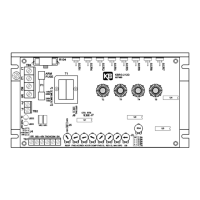5
D. J5 – Analog Input Voltage –
Jumper J5 is set to the “15V”
position for potentiometer
operation. If the control is to be
operated from an isolated 0 –
±10VDC signal, set J5 to the
“10V” position. (See sec. V, F, p.
10.) (See fig. 3.)
FIG. 3 – JUMPER J5 SETTING
Potentiometer Operation Signal Following
E. J6 – Control Mode – Speed (SPD) or Torque (TRQ). (Note: Factory setting of J6 is
Speed mode.) In the speed control mode (J6 set to SPD), the KBRG-212D will provide
variable speed control. The motor speed will be in direct proportion to the input signal.
Both forward and reverse torque are used to stabilize motor speed. (See fig. 4.)
FIG. 4 – SPEED CONTROL MODE
In the torque control mode (J6 set to TRQ), the KBRG-212D will vary the maximum motor
torque as a function of the voltage input to terminals “SIG” (signal) and “COM” (common).
This voltage can be derived from the wiper of the main potentiometer or from an isolated
analog input (voltage following). If the motor torque is greater than the load torque, the
motor will rotate. If no load is applied to the motor, the motor will rotate at a speed
proportional to the torque setting as set by the main potentiometer (see fig. 5, p. 6). By
using the ACCEL and DECEL trimpots, the application of torque can be made more
gradual or less gradual as required by the application. A maximum torque can be
established using the current selector jumper, J3, which can be further modified by using
the FWD and REV CL trimpots.
F. J7 – Coast to Stop (CTS), Regenerate to Stop (RTS) – This function operates in
conjunction with the Enable circuit, which is used to start and stop the control electroni-
cally. If the circuit connecting terminals “EN” and “COM” on terminal block TB1 is opened,
the control will cause the motor to stop. When jumper J7 is in the factory position (RTS),
the motor will regenerate to a stop. The stop time is controlled by the Forward
Acceleration (FWD ACC) and Reverse Acceleration (REV ACC) trimpots.
If J7 is changed to the coast to stop (CTS) position, the motor will coast to a stop when
the “EN” - “COM” circuit is opened. Note: Control will not run unless a jumper or
closed contact is connected between the “EN” and “COM” terminals.

